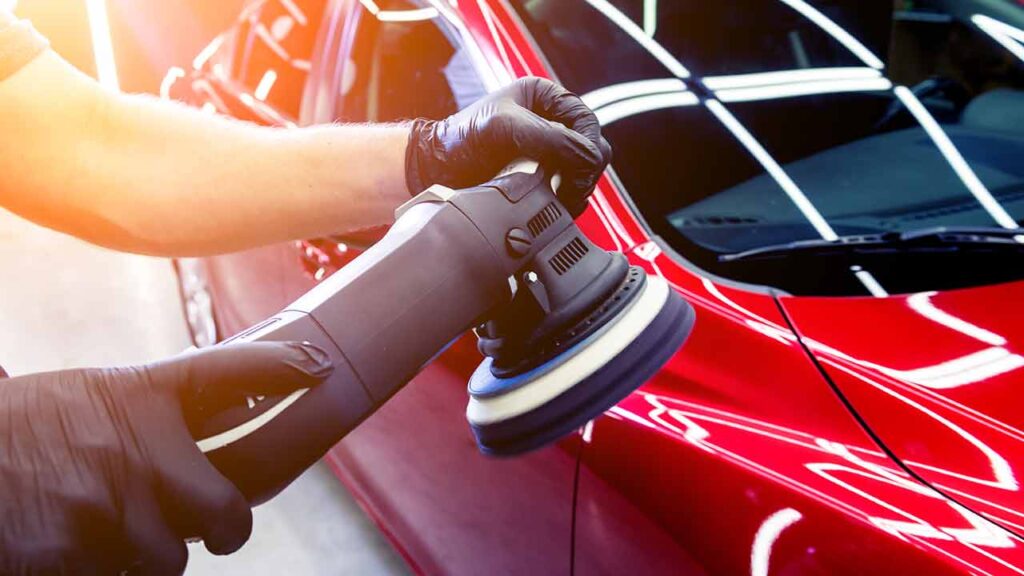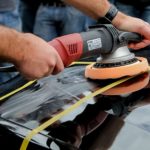Machine polishing is a method used to enhance the appearance of a vehicle’s exterior by removing imperfections and restoring shine. Unlike hand polishing, which relies on manual effort to apply and remove polish, machine polishing utilizes powered devices to achieve more consistent and efficient results. There are primarily two types of machine polishers: dual action and rotary.
Dual action polishers, also known as random orbital polishers, move in two directions simultaneously, which reduces the risk of damaging the car’s paint. This type is ideal for beginners due to its user-friendly nature. Rotary polishers, on the other hand, rotate in a single direction and are more powerful. They are typically used by professionals to correct severe paint defects, as they require more skill to operate without causing damage.
The materials used in machine polishing include various polish compounds and pads. Polish compounds are formulated with abrasives that help to smooth out surface imperfections. These compounds range from heavy-cut for significant defects to fine polish for minor imperfections and finishing touches. Pads, which attach to the polisher, come in different types and grades, such as foam, microfiber, and wool, each suited for specific tasks and polish compounds.
There are several benefits to using a machine polisher on a car’s exterior. It provides a higher level of correction and a more uniform finish than hand polishing. The machine’s power allows for quicker results, making it an efficient option for both enthusiasts and professionals. Additionally, machine polishing can enhance the depth and clarity of the paint, giving the car a more vibrant appearance.
However, there are potential drawbacks to consider. Improper use of a machine polisher can lead to paint damage, such as swirl marks or even burning through the clear coat. It is essential to understand the correct techniques and use the appropriate materials to avoid these issues. Furthermore, machine polishers can be an initial financial investment, though the long-term benefits often justify the cost.
Benefits of Machine Polishing
Machine polishing offers a multitude of advantages for maintaining and enhancing the appearance of your vehicle. One of the primary benefits is its ability to remove surface imperfections more effectively than hand polishing. Swirl marks, scratches, oxidation, and water spots are common issues that can detract from your car’s aesthetic appeal. Machine polishers, equipped with various pads and compounds, can address these imperfections with precision, restoring the paint to a smoother, more uniform finish.
Efficiency is another significant benefit of machine polishing. Unlike hand polishing, which can be labor-intensive and time-consuming, machine polishing allows for quicker and more consistent results. The mechanical action of the polisher can cover larger areas in less time, making it an excellent choice for both amateur car enthusiasts and professional detailers aiming to achieve optimal results without extensive manual effort.
Moreover, machine polishing can profoundly enhance the car’s appearance by restoring its shine and gloss. The process effectively removes contaminants that can dull the paint, revealing a more vibrant and reflective surface. This not only improves the visual appeal but also provides a protective layer that can extend the life of the paint. Regular machine polishing can help maintain your car’s exterior, ensuring it remains in pristine condition for longer periods.
Expert opinions and testimonials further underscore the benefits of using a machine polisher. For instance, automotive detailing professionals often recommend machine polishing for its superior results. One expert notes, “Machine polishing allows us to achieve a level of finish that simply isn’t possible with hand polishing.
It’s a game-changer in terms of both efficiency and quality.” Similarly, many car owners have reported satisfaction with the ease and effectiveness of machine polishing, citing noticeable improvements in their vehicle’s appearance.
Potential Risks and Drawbacks
While machine polishing can enhance the appearance of your car, there are several potential risks and drawbacks to consider. One of the most significant risks is the possibility of paint damage if the polisher is used incorrectly. Issues such as burning through the paint or creating holograms can occur, particularly if the user lacks experience. These mistakes can lead to costly repairs and diminish the overall value and aesthetics of the vehicle.
The skill and experience required to achieve the desired results cannot be understated. Machine polishing involves a steep learning curve, and improper technique can easily result in unintended damage. It is crucial to understand the nuances of different paint types and the appropriate pressure and speed settings required for each. Novices may find it challenging to produce a professional finish without extensive practice and guidance.
Another consideration is the cost associated with machine polishing. High-quality polishers, pads, and compounds can be expensive, making the initial investment substantial. Additionally, there are ongoing costs for maintenance and the periodic replacement of consumables. These financial commitments may be a deterrent for some car owners, particularly if they are only planning to polish occasionally.
To mitigate these risks, it is advisable to select the right type of machine and products for your specific needs. Dual-action polishers, for instance, are generally more user-friendly and less likely to cause damage compared to rotary polishers. Starting with a less visible area of the car for practice can also help build confidence and skill before moving on to more prominent sections. It is also beneficial to seek out educational resources, such as tutorials and courses, to improve technique and knowledge.
Best Practices for Machine Polishing
Machine polishing can significantly enhance the appearance of your car, but it requires careful preparation and execution to achieve the best results. The process begins with thorough surface preparation. Start by washing your car meticulously to remove all dirt, grime, and contaminants. Following this, use a clay bar to further cleanse the surface, eliminating any embedded particles that could scratch the paint during polishing.
Once your car’s surface is clean, you can begin the machine polishing process. Selecting the right equipment is crucial. A dual-action polisher is recommended for beginners due to its safety and ease of use. Choose appropriate polishing pads and compounds based on the condition of your car’s paint. For instance, a cutting pad with a more abrasive compound can be used to remove deeper scratches, while a finishing pad with a fine polish will enhance gloss and clarity.
When using the machine polisher, start by applying a small amount of polish to the pad. Spread the polish on a small section of the car, typically no larger than 2 feet by 2 feet. This ensures you can maintain control and monitor your progress effectively. Set the machine to a low speed to spread the polish evenly, then gradually increase the speed to work the polish into the surface. Apply moderate pressure and keep the pad moving to avoid heat buildup, which can damage the paint.
Regularly inspect the area you are working on to gauge your progress. Once satisfied, wipe off any residue with a clean microfiber cloth. After polishing, it’s essential to protect the surface. Apply a high-quality wax or sealant to preserve the shine and provide a barrier against environmental elements. This step not only enhances the visual appeal but also prolongs the life of the polished finish.
For those new to machine polishing, starting with a dual-action polisher is advisable. It offers a balance of cutting power and safety, reducing the risk of damaging the paint. By adhering to these best practices, you can achieve a professional-level finish while maintaining the integrity of your car’s paintwork.



